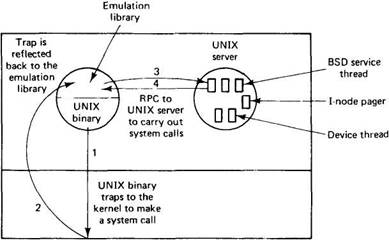Книга: Distributed operating systems
8.5. UNIX EMULATION IN MACH
8.5. UNIX EMULATION IN MACH
Mach has various servers that run on top of it. Probably the most important one is a program that contains a large amount of Berkeley UNIX (e.g., essentially the entire file system code) inside itself. This server is the main UNIX emulator (Golub et al., 1990). This design is a legacy of Mach's history as a modified version of Berkeley UNIX.
The implementation of UNIX emulation on Mach consists of two pieces, the UNIX server and a system call emulation library, as shown in Fig. 8-21. When the system starts up, the UNIX server instructs the kernel to catch all system call traps and vector them to addresses inside the emulation library of the UNIX process making the system call. From that moment on, any system call made by a UNIX process will result in control passing temporarily to the kernel and immediately thereafter passing to its emulation library. At the moment control is given to the emulation library, all the machine registers have the values they had at the time of the trap. This method of bouncing off the kernel back into user space is sometimes called the trampoline mechanism.

Fig. 8-21. UNIX emulation in Mach uses the trampoline mechanism.
Once the emulation library gets control, it examines the registers to determine which system call was invoked. It then makes an RPC to another process, the UNIX server, to do the work. When it is finished, the user program is given control again. This transfer of control need not go through the kernel.
When the init process forks off children, they automatically inherit both the emulation library and the trampoline mechanism, so they, too, can make UNIX system calls. The EXEC system call has been changed so that it does not replace the emulation library but just the UNIX program part of the address space.
The UNIX server is implemented as a collection of C threads. Although some threads handle timers, networking, and other I/O devices, most threads handle BSD system calls, carrying out requests on behalf of the emulators inside the UNIX processes. The emulation library communicates with these threads using the usual Mach interprocess communication.
When a message comes in to the UNIX server, an idle thread accepts it, determines which process it came from, extracts the system call number and parameters from it, carries it out, and finally, sends back the reply. Most messages correspond exactly to one BSD system call.
One set of system calls that work differently are the file I/O calls. They could have been implemented like this, but for performance reasons, a different approach was taken. When a file is opened, it is mapped directly into the caller's address space, so the emulation library can get at it directly, without having to do an RPC to the UNIX server. To satisfy a READ system call, for example, the emulation library locates the bytes to be read in the mapped file, locates the user buffer, and copies from the former to the latter as fast as it can.
Page faults will occur during the copy loop if the file's pages are not in memory. Each fault will cause Mach to send a message to the external memory manager backing up the mapped UNIX file. This memory manager is a thread inside the UNIX server called the i-node pager. It gets the file page from the disk and arranges for it to be mapped into the application program's address space. It also synchronizes operations on files that are open by several UNIX processes simultaneously.
Although this method of running UNIX programs looks cumbersome, measurements have shown that it compares favorably with traditional monolithic kernel implementations (Golub et al., 1990). Future work will focus on splitting the UNIX server into multiple servers with more specific functions. Eventually, the single UNIX server may be eliminated, although this depends on how the work with multiple servers develops during the course of time.
- 8 Case Study 2: Mach
- 8.1.3. The Mach Microkernel
- 9.4. COMMUNICATON IN CHORUS
- Генеалогия UNIX
- Об администрировании UNIX
- Межпроцессное взаимодействие в BSD UNIX. Сокеты
- Сопоставление с UNIX и библиотекой С
- Глава 8. Wi-Fi для Unix
- 2.4. Уроки истории Unix
- 21.1.2 Ориентация на Unix
- 4.5. Unix и объектно-ориентированные языки
- Глава 1 UNIX для начинающих




